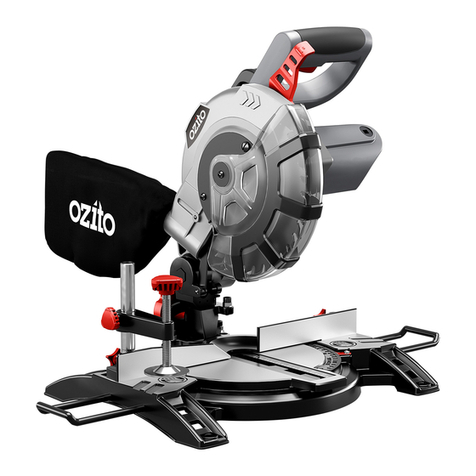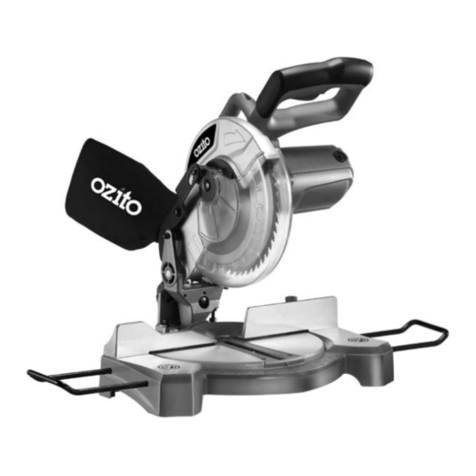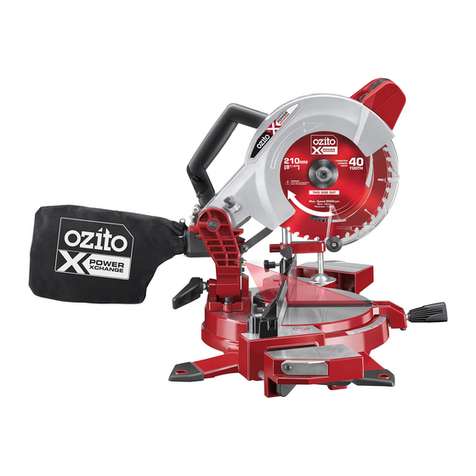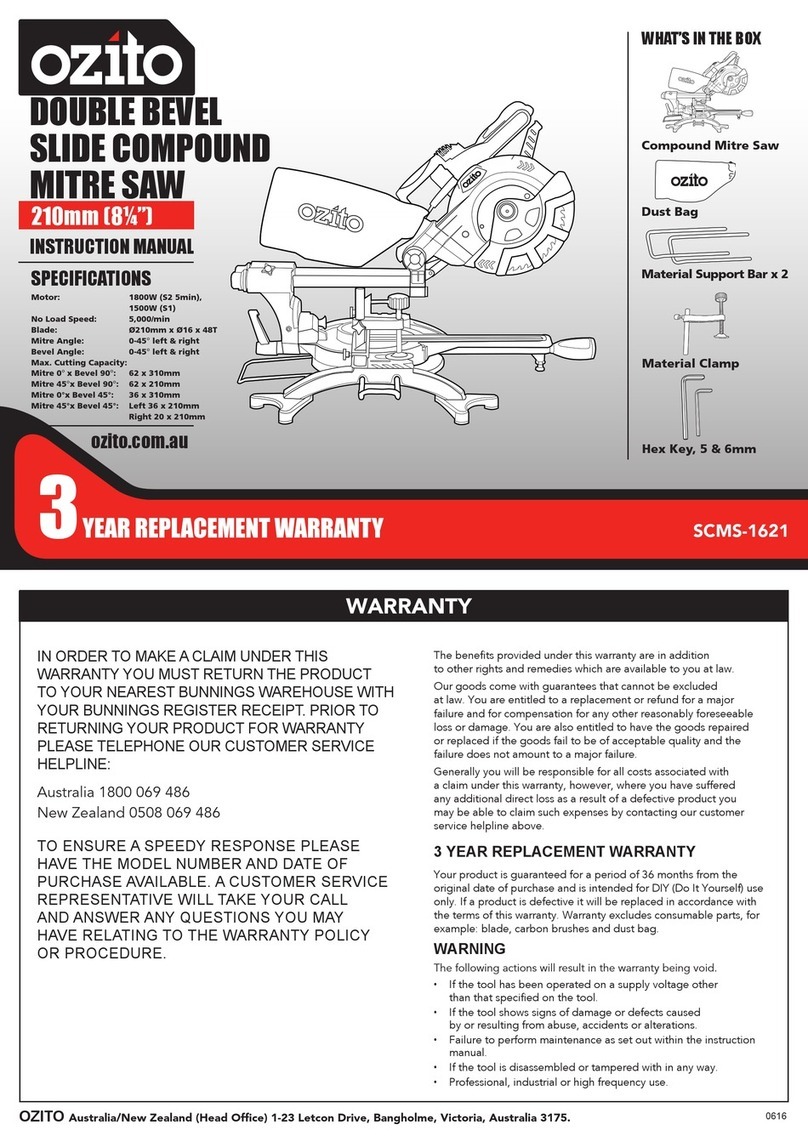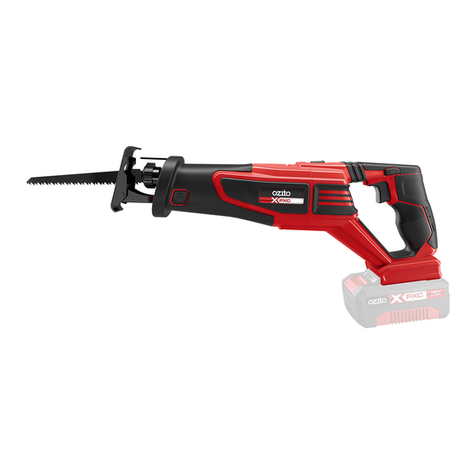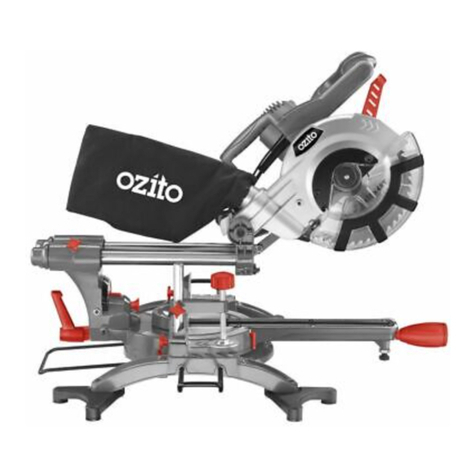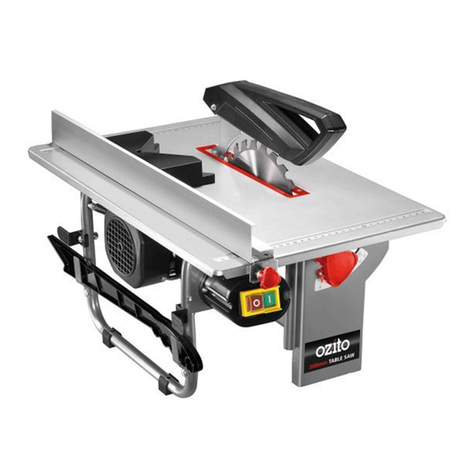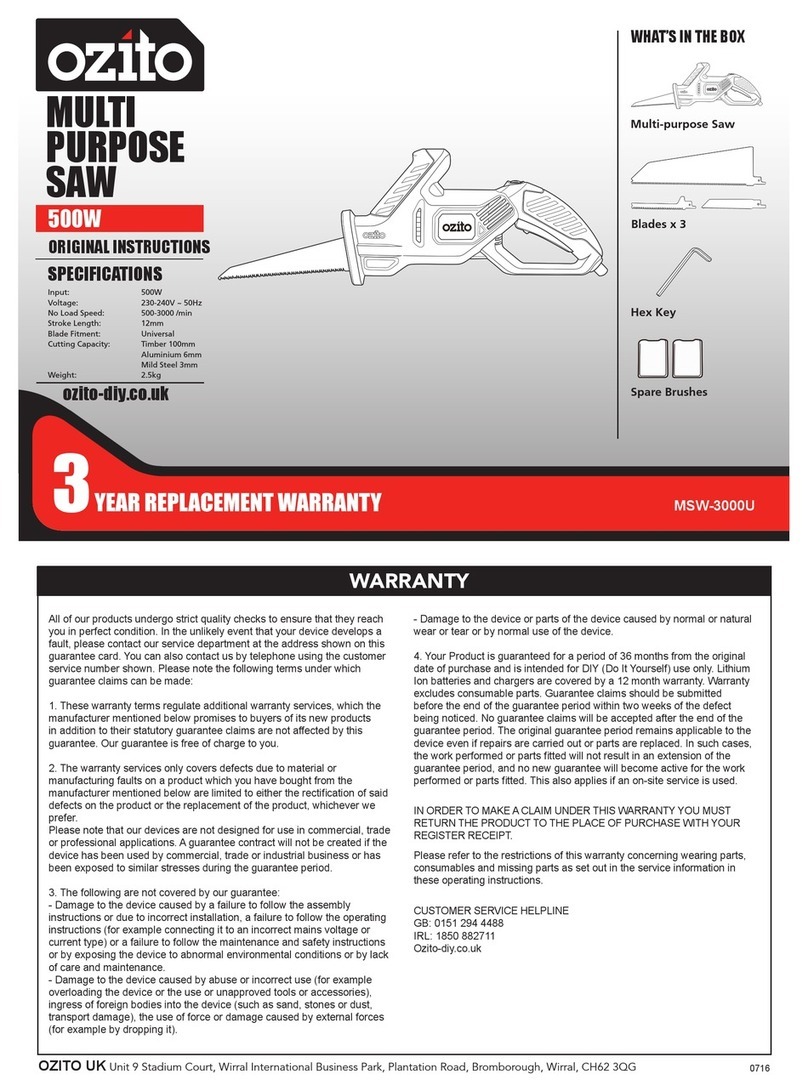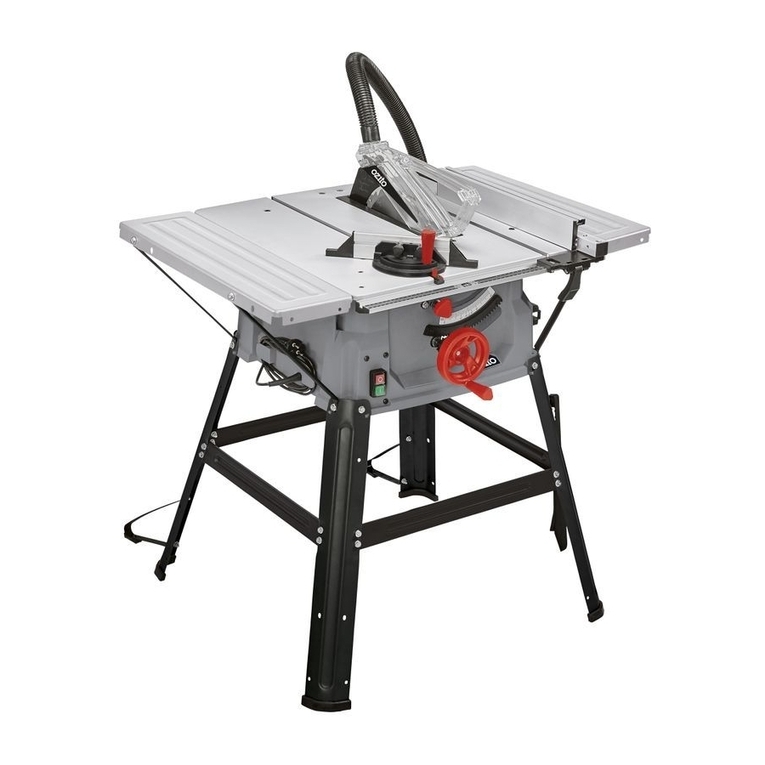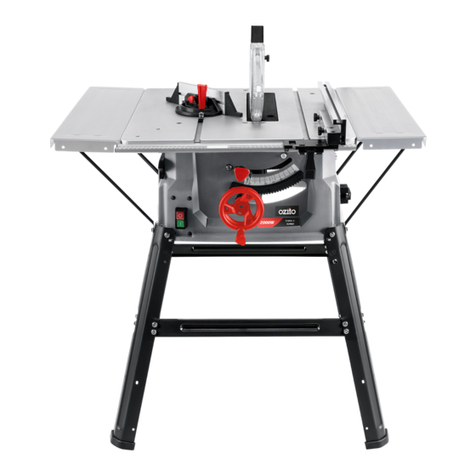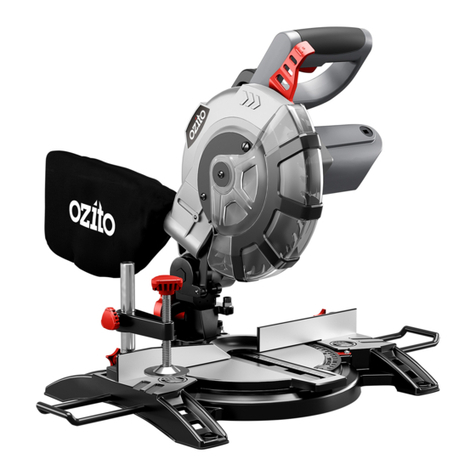Hold power tool by insulated gripping surfaces, when performing an operation where the
cutting accessory may contact hidden wiring or its own cord. Cutting accessory contacting a
“live” wire may make exposed metal parts of the power tool “live“ and could give the operator an
electric shock.
This appliance is not intended for use by persons (including children) with reduced physical,
sensory or mental capabilities, or lack of experience and knowledge, unless they have been given
supervision or instruction concerning use of the appliance by a person responsible for their safety
Children should be supervised to ensure that they don’t play with the appliance.
• Pull out all nails in the material before starting to saw. Cutting nails may damage your tool.
• Do not operate your band saw until it is completely assembled and installed according to the
instructions and until you have read and understood all of the instructions.
• Do not touch moving parts with your ngers or hands.
• Ensure that you have tightened the blade prior to starting the machine.
• When nishing sawing, wait until the saw blade has ceased moving prior to removing it from the
material.
• Do not touch the saw blade immediately after use. Allow time for the blade to cool, otherwise it
could burn you due to the heat generated during sawing.
• Always check accessories to ensure that they are suitable for the operating speeds of this tool.
• Incorrect accessories can break apart at high speed and cause serious damage or personal
injury.
• Never turn your band saw on before clearing the table of all objects (tools, scraps of wood, etc.)
except for the work piece.
• Hold the work rmly against the table.
• Do not feed the material too fast while cutting. Only feed the material fast enough so that the
blade will cut.
• Never leave the band saw running unattended. Always turn the saw off, make sure that it has
come to a complete stop, and then remove plug from the power supply before leaving the work
area.
• Use caution when cutting off material which is irregular in cross section as it could pinch the
blade before the cut is completed. A piece of moulding, for example, must lay at on the table
and not be permitted to rock whilst being cut.
• Do not use saw bands which are damaged or deformed.
• When cutting round timber use a suitable device to prevent twisting of the workpiece.
• When bevel-cutting with the table inclined, place the guide on the lower part of the table.
• Connect band saws to a dust-collecting device when operating.
WARNING! Some dust created by sanding, sawing, grinding, drilling and other
construction activities contain chemicals known to cause cancer, birth defects or
other reproductive harm. Some examples of these chemicals are:
• Lead from lead-based paints;
• Crystalline silica from bricks, cement and other masonry products, and;
• Arsenic and chromium from chemically-treated timber.
The risk from such exposures vary depending on how often you do this type of work. To reduce
your exposure to these chemicals; work in a well ventilated area, and work with approved safety
equipment, such as those dust masks that are specically designed to lter out microscopic
particles.
Always wear eye protection and a dust mask for dusty applications and when drilling/ chiselling
overhead. Sanding particles can be absorbed by your eyes and inhaled easily and may cause
health complications.
Caution: Always Wear safety goggles, ear protection and a respiratory mask.
BAND SAW SAFETY WARNINGS
WARNING! When using mains-powered tools, basic safety precautions, including the
following, should always be followed to reduce risk of re, electric shock, personal injury
and material damage.
Read the whole manual carefully and make sure you know how to switch the tool off in an emergency, before
operating the tool.
Save these instructions and other documents supplied with this tool for future reference.
The electric motor has been designed for 230V and 240V only. Always check that the power supply
corresponds to the voltage on the rating plate.
Note: The supply of 230V and 240V on Ozito tools are interchangeable for Australia and New Zealand.
If the supply cord is damaged, it must be replaced by an electrician or a power tool repairer in order to avoid
a hazard.
To reduce the risk of electric shock, we recommend the use of a residual current device (rated at 30mA or
less).
Using an Extension Lead
Always use an approved extension lead suitable for the power input of this tool. Before use, inspect the
extension lead for signs of damage, wear and ageing. Replace the extension lead if damaged or defective.
When using an extension lead on a reel, always unwind the lead completely. Use of an extension lead not
suitable for the power input of the tool or which is damaged or defective may result in a risk of re and electric
shock.
GENERAL POWER TOOL SAFETY WARNINGS
ELECTRICAL SAFETY
WARNING! Read all safety warnings and all instructions. Failure to follow the warnings and
instructions may result in electric shock, re and/or serious injury.
Save all warnings and instructions for future reference. The term “power tool” in the
warnings refers to your mains-operated (corded) power tool or battery-operated (cordless) power
tool.
1. Work area safety
a. Keep work area clean and well lit. Cluttered or dark areas invite accidents.
b. Do not operate power tools in explosive atmospheres, such as in the presence of ammable
liquids, gases or dust. Power tools create sparks which may ignite the dust or fumes.
c. Keep children and bystanders away while operating a power tool. Distractions can cause you to
lose control.
2. Electrical safety
a. Power tool plugs must match the outlet. Never modify the plug in any way. Do not use any
adapter plugs with earthed (grounded) power tools. Unmodied plugs and matching outlets will
reduce risk of electric shock.
b. Avoid body contact with earthed or grounded surfaces, such as pipes, radiators, ranges and
refrigerators. There is an increased risk of electric shock if your body is earthed or grounded.
c. Do not expose power tools to rain or wet conditions. Water entering a power tool will increase the
risk of electric shock.
d. Do not abuse the cord. Never use the cord for carrying, pulling or unplugging the power tool.
Keep cord away from heat, oil, sharp edges or moving parts. Damaged or entangled cords increase
the risk of electric shock.
e. When operating a power tool outdoors, use an extension cord suitable for outdoor use. Use of a
cord suitable for outdoor use reduces the risk of electric shock.
f. If operating a power tool in a damp location is unavoidable, use a residual current device (RCD)
protected supply. Use of an RCD reduces the risk of electric shock.
3. Personal safety
a. Stay alert, watch what you are doing and use common sense when operating a power tool. Do
not use a power tool while you are tired or under the inuence of drugs, alcohol or medication. A
moment of inattention while operating power tools may result in serious personal injury.
b. Use personal protective equipment. Always wear eye protection. Protective equipment such as dust
mask, non-skid safety shoes, hard hat, or hearing protection used for appropriate conditions will reduce
personal injuries.
c. Prevent unintentional starting. Ensure the switch is in the off-position before connecting to
power source and/or battery pack, picking up or carrying the tool. Carrying power tools with your
nger on the switch or energising power tools that have the switch on invites accidents.
d. Remove any adjusting key or wrench before turning the power tool on. A wrench or a key left
attached to a rotating part of the power tool may result in personal injury.
e. Do not overreach. Keep proper footing and balance at all times. This enables better control of the
power tool in unexpected situations.
f. Dress properly. Do not wear loose clothing or jewellery. Keep your hair, clothing and gloves away
from moving parts. Loose clothes, jewellery or long hair can be caught in moving parts.
g. If devices are provided for the connection of dust extraction and collection facilities, ensure
these are connected and properly used. Use of dust collection can reduce dust-related hazards.
4. Power tool use and care
a. Do not force the power tool. Use the correct power tool for your application. The correct power tool
will do the job better and safer at the rate for which it was designed.
b. Do not use the power tool if the switch does not turn it on and off. Any power tool that cannot be
controlled with the switch is dangerous and must be repaired.
c. Disconnect the plug from the power source and/or the battery pack from the power tool before
making any adjustments, changing accessories, or storing power tools. Such preventive safety
measures reduce the risk of starting the power tool accidentally.
d. Store idle power tools out of the reach of children and do not allow persons unfamiliar with the
power tool or these instructions to operate the power tool. Power tools are dangerous in the hands
of untrained users.
e. Maintain power tools. Check for misalignment or binding of moving parts, breakage of parts and
any other condition that may affect the power tool’s operation. If damaged, have the power tool
repaired before use. Many accidents are caused by poorly maintained power tools.
f. Keep cutting tools sharp and clean. Properly maintained cutting tools with sharp cutting edges are
less likely to bind and are easier to control.
g. Use the power tool, accessories and tool bits etc. in accordance with these instructions, taking
into account the working conditions and the work to be performed. Use of the power tool for
operations different from those intended could result in a hazardous situation.
5. Service
a. Have your power tool serviced by a qualied repair person using only identical replacement
parts. This will ensure that the safety of the power tool is maintained.
